This post is for parents or caregivers who want to help their child learn to read. This post is geared toward beginning readers, so it will cover strategies for teaching phonics. There is a lot more to reading than phonics, but mastering phonics provides the essential foundation, so that is where we will begin.
What is Phonics?
Phonics is a method of teaching reading that focuses on the relationship between letters and sounds. By learning phonics, children understand how letters (and groups of letters) represent specific sounds, which helps them decode, or “sound out”, words. Phonics helps children connect the sounds of spoken language to the letters and words they see on the page. This skill is essential, as it gives children the tools they need to read unfamiliar words.
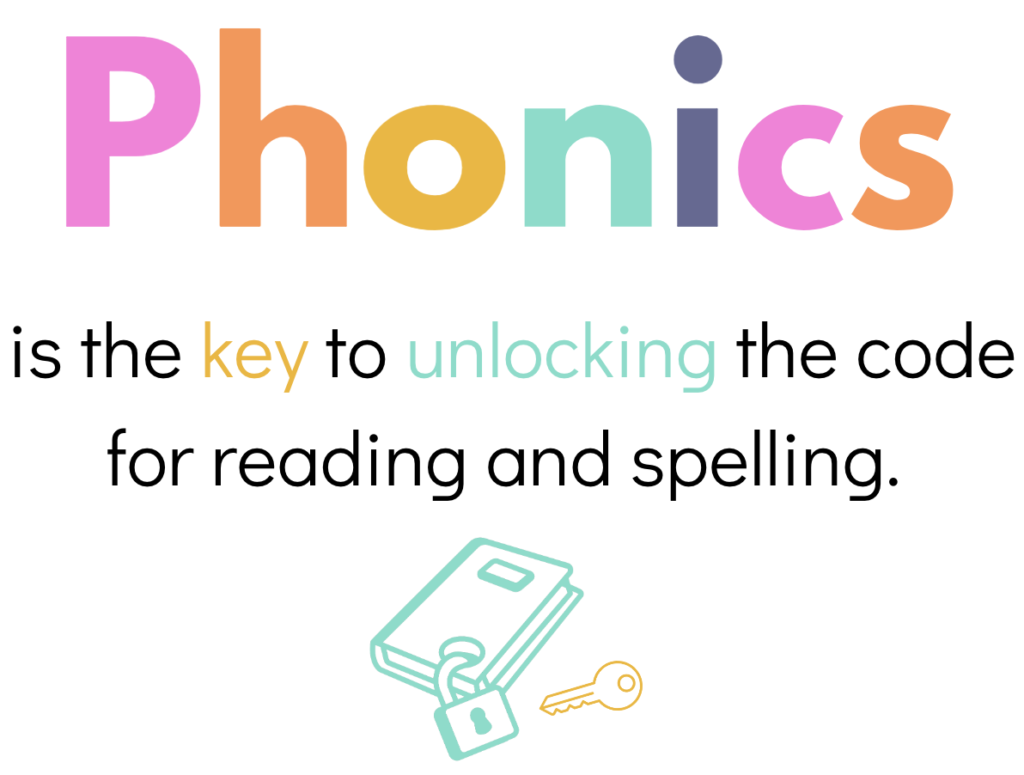
Think of phonics as instruction that allows students to break “the code” that translates written language into spoken language (and vice versa!). Just like in a code, you need to know the “key” to unlock it. In reading, this “key” is knowing the sounds that each letter or letter combination makes. Phonics gives children the tools (“the keys”) to decode unfamiliar words.
Core Phonics Skills: Decoding and Encoding
In addition to decoding (matching letters to sounds and blending those sounds to read the word), the other phonics skill that students work on is encoding. Encoding is the process of spelling words by breaking down spoken sounds and representing them with letters or letter combinations. It’s the reverse of decoding.
Decoding and Encoding require two things:
- Sound-symbol awareness: knowing the letters and the sounds those letters make
- Phonemic awareness: The ability to hear and manipulate the smallest sounds in words. The two primary phonemic awareness skills are blending sounds (putting /s/ /a/ /t/ together to say “sat”) and segmenting sounds (hearing “sat” and being able to break it up into its sounds: /s/ /a/ /t/).
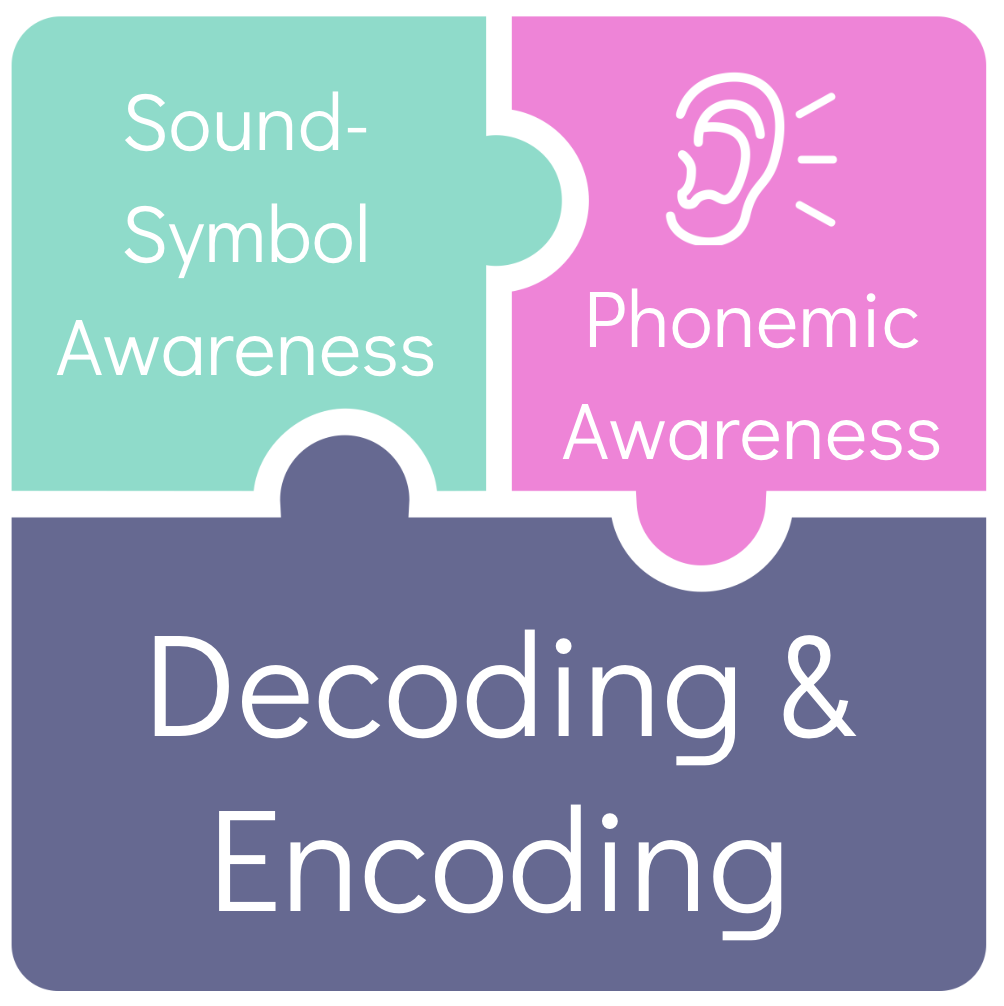
Debunking Myths About Learning to Read
For a while, it was believed that reading was a natural process and that words could be memorized just by looking at the shape over and over and by getting exposed to words and books. 50 years of research has debunked these myths.
Reading is NOT a natural skill. True, some kids seemingly pick it up with ease, but that is not the majority. Words are not learned as whole parts, and simply reading them to your children will not ensure that they become proficient readers. Reading is an acquired skill. With the right instruction and opportunities to practice, our brains create new circuits that connect the language-processing parts with the visual-processing parts. For more about how the brain learns to read, click here.
Although it may seem like words are memorized as a whole, “the brain processes every single letter and does not look at the whole word shape” (Stanislas Dehaene, 2010). Automatic word recognition (recognizing a word instantly) is reached through a process called orthographic mapping. I will refer to this later, but if you would like to learn more, check out this post.
Why does Teaching Phonics matter?
Phonics helps your child learn to read and spell. Our written language is much like a code and phonics is how we break that code. Research shows that phonics is essential to beginning reading instruction. In 2000, the National Reading Panel reviewed thousands of studies and concluded that early instruction in phonics is the best way to teach children how to read.
How to Teach Phonics:
When teaching reading through phonics, it’s helpful to think of the process like climbing a staircase. Just as each step must be taken one at a time to reach the top, phonics concepts are introduced in a specific sequence, with each new foundational element building on the one before it. This structured, step-by-step approach allows students to develop decoding and encoding skills, ultimately building toward automatic word recognition and fluent reading. Teachers or parents can guide their students from simple letter sounds to complex multisyllabic words, ensuring that each level of skill is mastered before moving on to the next.

The image above illustrates the staircase analogy for phonics instruction. Each step introduces a new phonics skill while building upon the ones learned before. This approach highlights the importance of teaching phonics in a systematic, sequential manner and reinforces the need for regular review to ensure mastery of previously taught concepts.
When teaching phonics, there are three things you need: a roadmap to tell you the order of skills, the right routines, and resources to practice the skills.
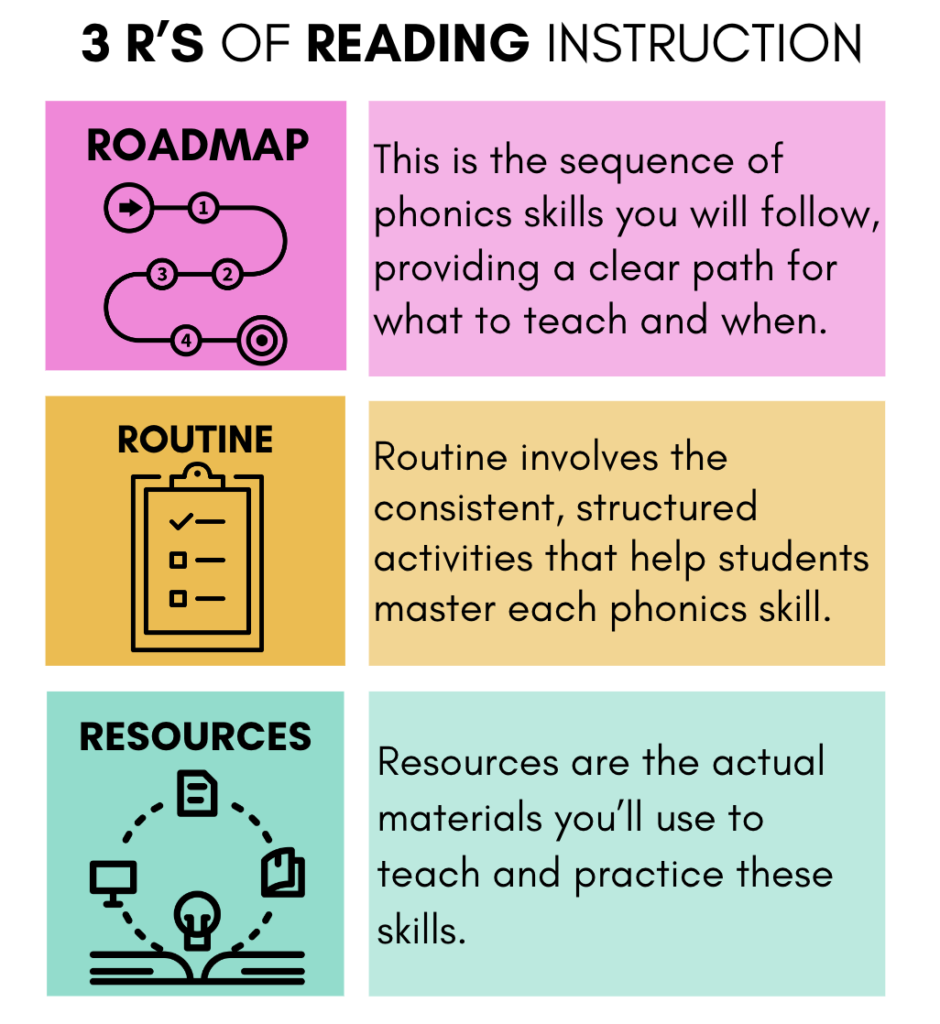
Roadmap:
A roadmap provides a clear path of what phonetic elements to teach and when. Following a pre-made phonics sequence helps students move step-by-step, building confidence as they progress toward reading fluency. Think of phonetic elements as the knowledge you want them to have in order to decode and encode words. This includes letter combinations like sh, ai, and igh as well as “rules” like what the silent e does to the other vowel.
In a perfect world, your child’s teacher would follow a scope and sequence provided by the school that flows from grade to grade. Unfortunately, not all schools are doing that. If your child’s teacher is following a phonics scope and sequence, ask for a copy of it so that you can reinforce skills at home in the same order. If your child is behind, it is essential to go back to those missing skills. It is not helpful to just keep trying to work at home on things that are too difficult. Find out what skills your child has mastered, and begin at the skill right after that.
If your child’s teacher does not follow a sequence, I have one that you can use. Most sequences are pretty similar, with only a few variations. There is not one “correct” sequence out there, but in general, there are agreements about which skills should be taught at the beginning, middle, and end.

The image above is presented as more of a timeline, while the image below shows examples of each phonetic element that should be taught. Click here to download both.
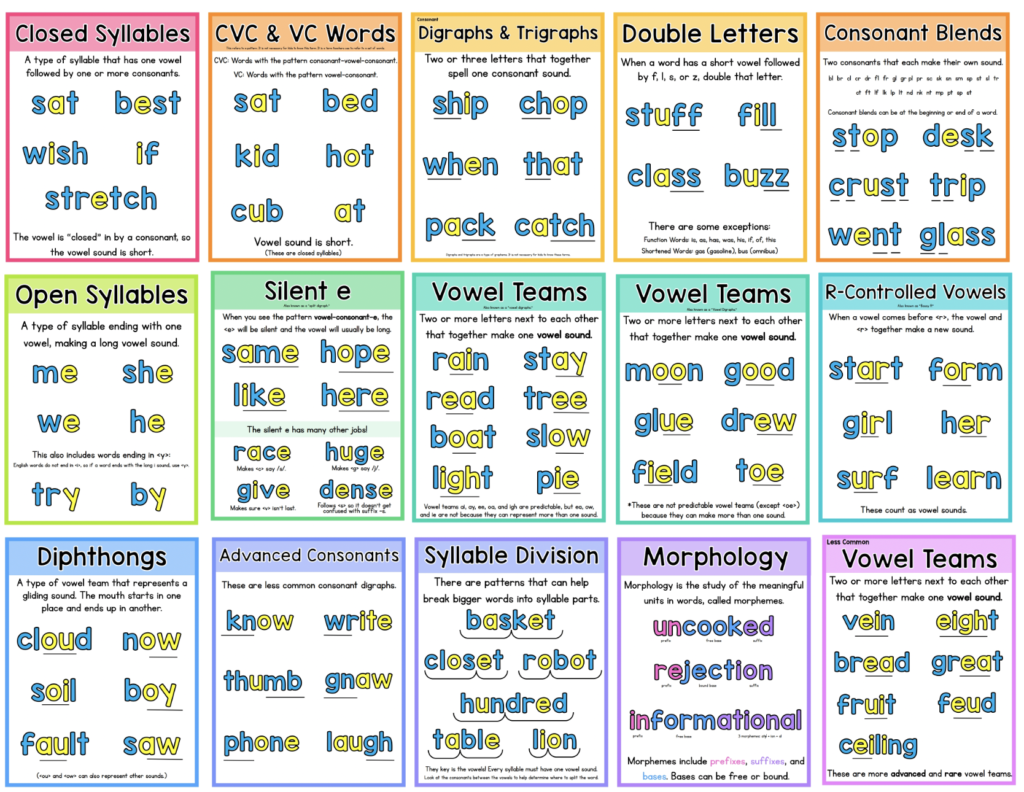
For my detailed Scope and Sequence (available for free), click here.
Routine:
A routine involves consistent, structured activities that help students master each phonics skill. Think of the roadmap of the “what and when” and the routine as the “how.”
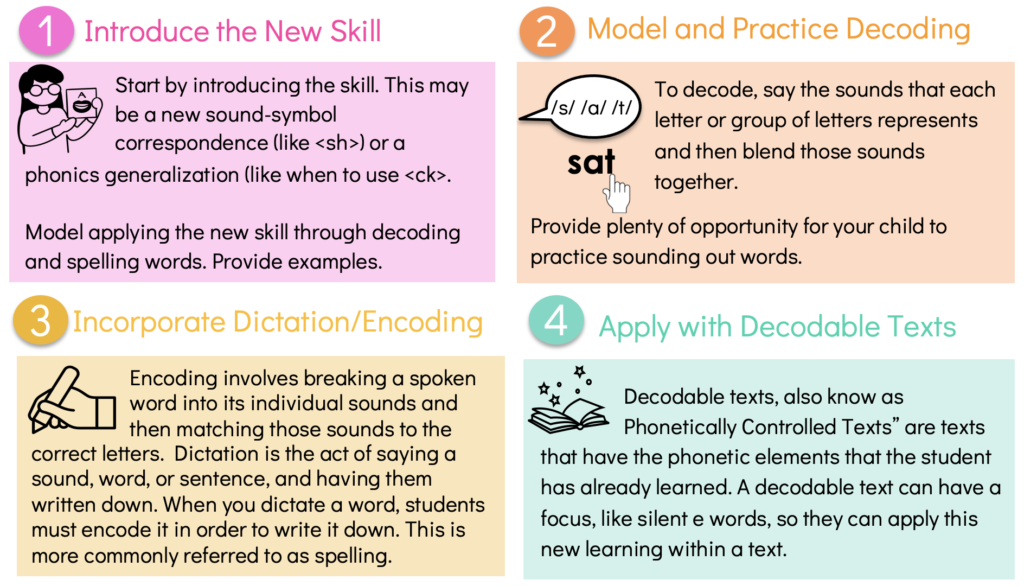
There is a lot more detail to add to each of these, but for the sake of simplicity, I wanted to keep it brief and to the point.
1. Introduce the New Skill
When I say “phonics skill,” I’m actually referring to one of the following:
- A new letter or letter combination (like <sh> or <ai> for example)
- A spelling generalization/”rule” (like when to use <ck> and when to use <k>)
- A spelling pattern (like vowel-consonant-e, which usually signals that the vowel will be long)
- A prefix or suffix
When you are teaching a new phonics skill, you will want to be direct. For example, when you are teaching <sh>, you may say, “These letters each make their own sounds, but when they are are together in this order, they will make one sound together. The letters <sh> spell /sh/ like in “shell”, “shop”, and “wish”. You will show a few examples of words that use <sh>.
2. Practice Decoding
After introducing the phonics skill, you will model how to apply this new learning by reading (decoding).
Use index cards or a whiteboard to write a word or use magnetic letters to build a word. Model how to decode a word. You will tap each letter and say the sounds. Then, go back and do it again, this time stretching the sounds that can be stretched. Blend the sounds together to read the word. Have your child repeat after you, then have them decode with you, and then they will decode on their own. (After some practice, you will not need to model sounding out the word twice. You will want your child to get used to stretching sounds the first time for easier blending.)
Once you’ve modeled, make sure to give your child plenty of practice decoding words with your target skill.
It’s important to know what kinds of words you will be decoding. As mentioned, you will decode words using your target skill. So for <sh>, you will model reading and spelling words like “shop”, “ship”, “dish”, “rash”. However, you will not use words like “shake” and “shark” because you have not taught all of those letter combinations. Remember the stair-step approach? Well, you will use your sequence to help you decide what words you can and can’t teach. In the word, “shake”, students must know the silent e rule, which is taught later, In “shark”, they would have to know the <ar> letter combination, which is taught much later.
There is more to learn about decoding. When you are ready, use the links below to learn more about decoding, including common challenges.
- Decoding Strategies Video
- Decoding Strategies: This blog post goes into more detail about how to teach decoding.
- Click here for a handout about common difficulties with decoding and how to help.
3. Incorporate Dictation/Encoding
As you did with decoding, you will also be modeling and providing practice with encoding (spelling).
Let’s first define the terms “dictation” and “encoding”. Encoding involves segmenting (breaking up) a spoken word into its individual sounds and then matching those sounds to letters. (This is more commonly known as “spelling”.)
One method of encoding is to use a manipulative (like a bingo chip or a penny) and “sound boxes”. Begin the chips in the boxes. Push a chip out of the boxes as you say each sound in the word. Then write the letter or letters that spell each sound in each box. The pictures below show two examples. Notice how the <sh> is in one box, not two. That is because <sh> together spells one sound.
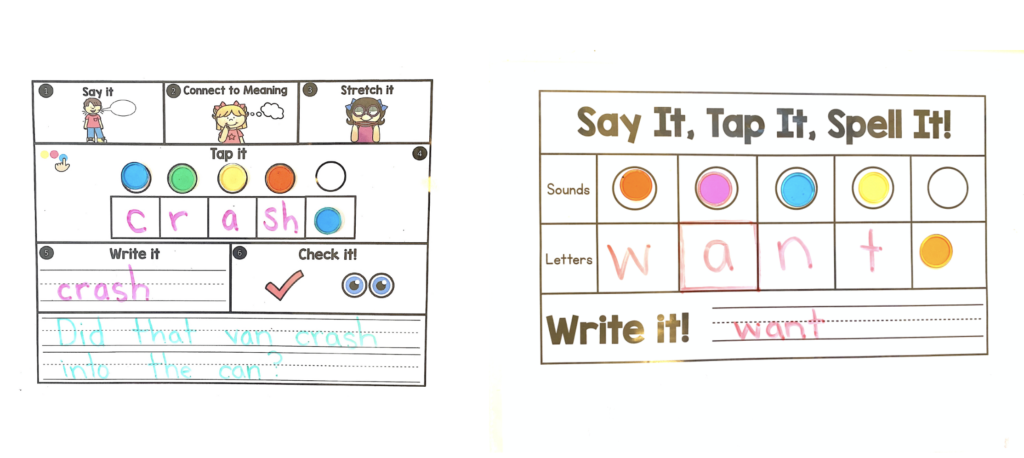
With dictation, someone says a word, phrase, or sentence for another person to write down. The person writing uses encoding to spell the words they are writing. If you are dictating a sentence, however, the student has more to think about than just spelling. They need to remember the conventions of a sentence, like punctuation and when to use capital letters. They also must remember to put spaces between the words. Remembering the words in the sentence is also challenging for some, because it requires working memory to hold those words in their mind while they are focusing on spelling one of the words.
The picture below shows an example of dictated words and a dictated sentence. The missing word illustrates one of the challenges of writing- remembering what you are writing and making sure all of those words are there! So, what is the follow-up to this? Have your child point to the words they just wrote and read them. Guide them in finding the word they left out. Another tip is while they write, have them reread what they have written and repeat the full sentence as they write each word.
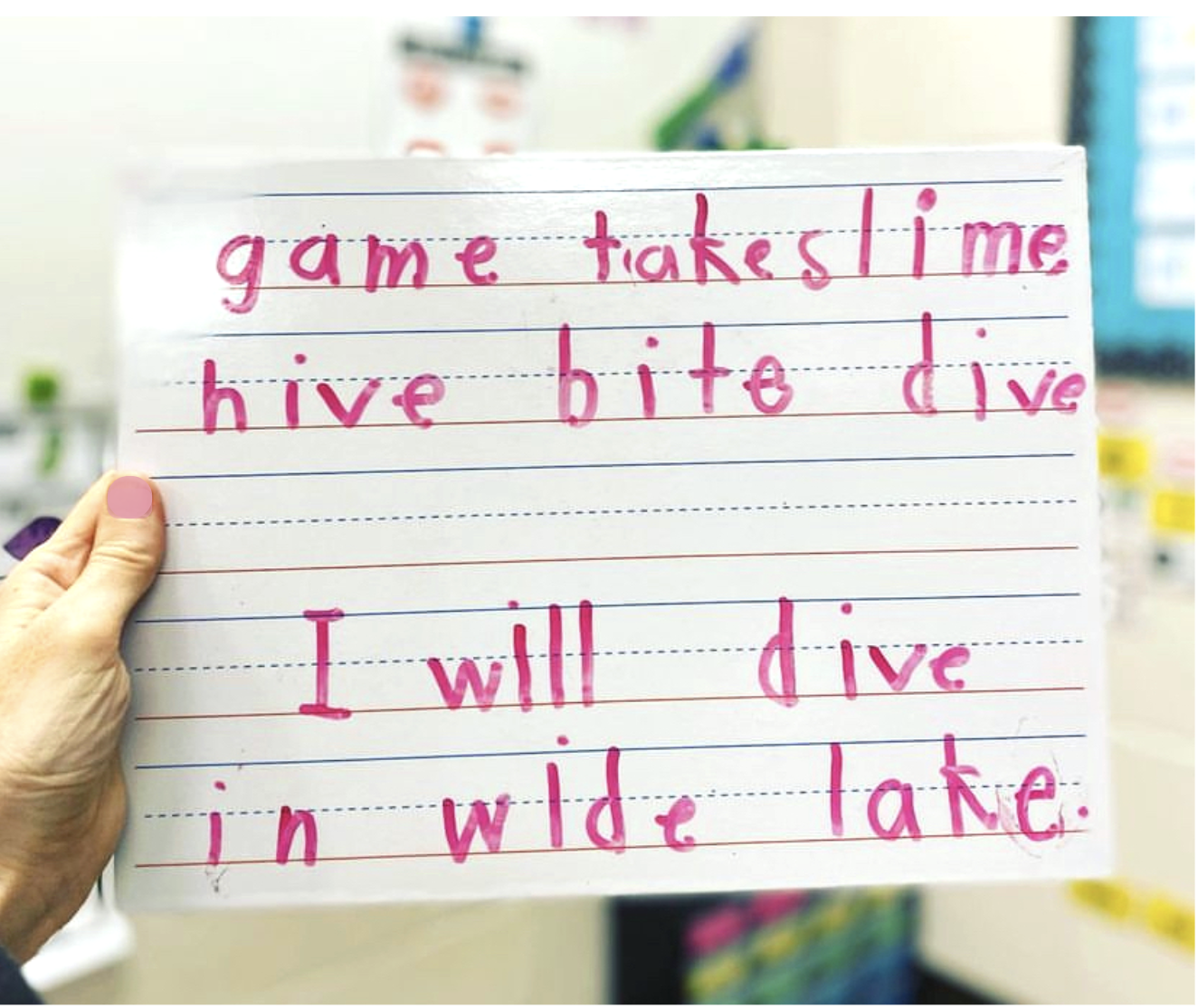
Spelling is often overlooked and underused, but don’t make that mistake! This is just as important as practicing decoding. It is typically much more difficult. Think of all the ways you can spell certain sounds. Additionally, working on spelling/encoding can improve reading; however, working on reading does not necessarily improve spelling. Spelling/encoding can lead to word recognition as well!
To learn more about encoding and dictation:
- Encoding Video
- Using “Sound Boxes” to help with Spelling
- Encoding and Dictation Blog Post
- Dictation video
- Click here for a handout about common difficulties with encoding and how to help.
- Click here for a handout explaining dictation steps.
Decodable Texts
Decodable texts are texts that are phonetically controlled, meaning they only have words that include phonics patterns and letter-sound combinations that have been taught. They often have a focus, so your child can apply their new learning. This step is essential! You never want your child to guess on a word. Using decodable texts allows for your child to have success with reading because they are not put in the position to have to guess. They have the tools they need to read that book.
Decodable texts are meant to be temporary- we use them while students are still acquiring new phonics skills. Once they have a strong enough foundation, they can move to more authentic texts. Think of these as an essential stepping stone from sounding out words in isolation to reading “real” books.
Decodable texts can be books, reading passages, or even just separate sentences or phrases. When your child is first learning a new phonetic element, they may need to begin with phrases or separate sentences. As they get more efficient at decoding and applying their new knowledge, they can move on to books and reading passages.
For more information about decodable texts:
- Read this blog post. It will give you links to decodable texts.
- Watch this video for a helpful tip to build fluency while using decodable books
- Video about providing corrective feedback
Resources
Resources are the actual materials you’ll use to teach these skills. Having the right resources ensures you’re equipped to teach effectively at every step of the roadmap, keeping students engaged and supporting their learning journey. Luckily, there are so many resources out there now! It can feel overwhelming, though.
Because there is so much out there, I want to simplify. I love all the bells and whistles as much as the next teacher, but to keep it simple, you should know the main things you will need (in addition to your roadmap/sequence).
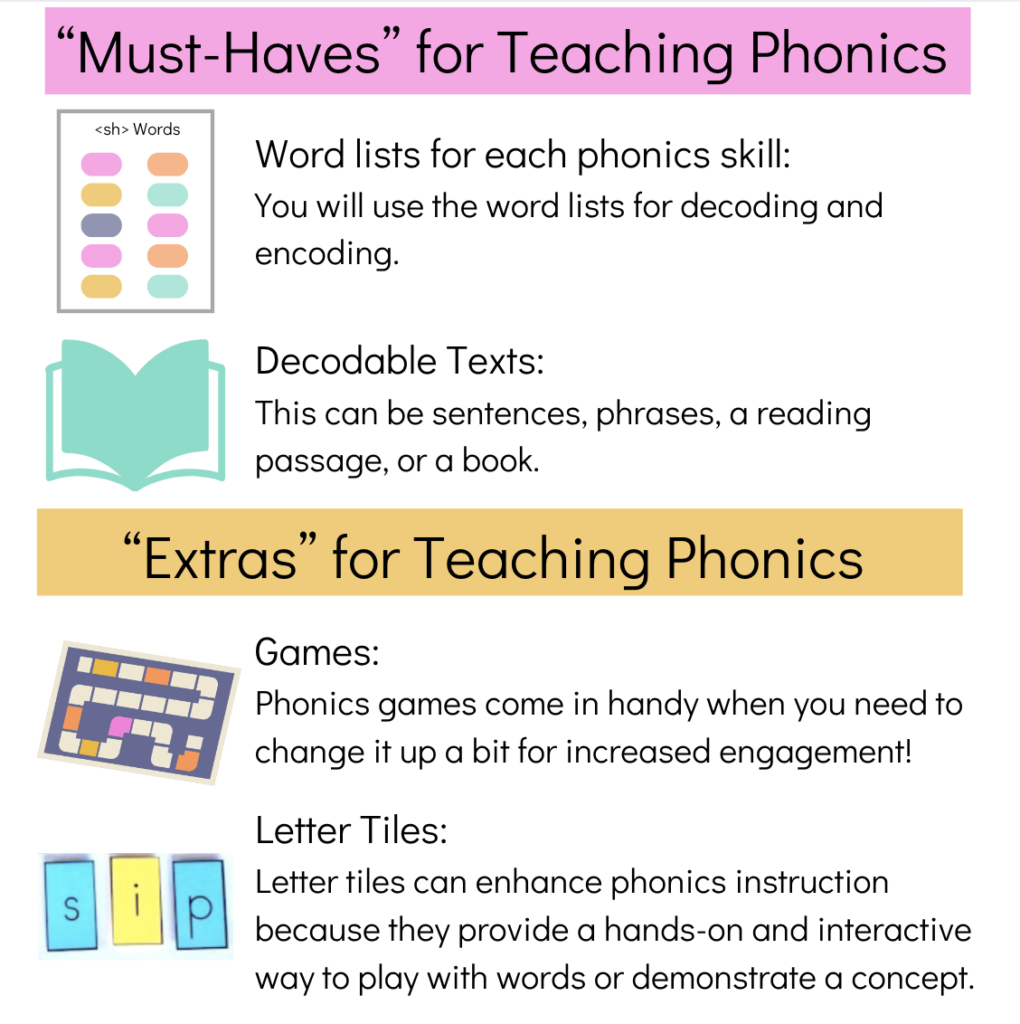
- To find lists of words for spelling and sentences for dictation, click here.
- For FREE letter tiles, click here.
- If you are looking for worksheets that provide practice with each skill, click here.
- To get ideas and links to decodable texts, check out this blog post.
- For phonics games, click here.
If you want more direction on how to teach these skills, you may be interested in this resource.
Putting it all Together
This handout summarizes this blog post on one page. Click here to download.
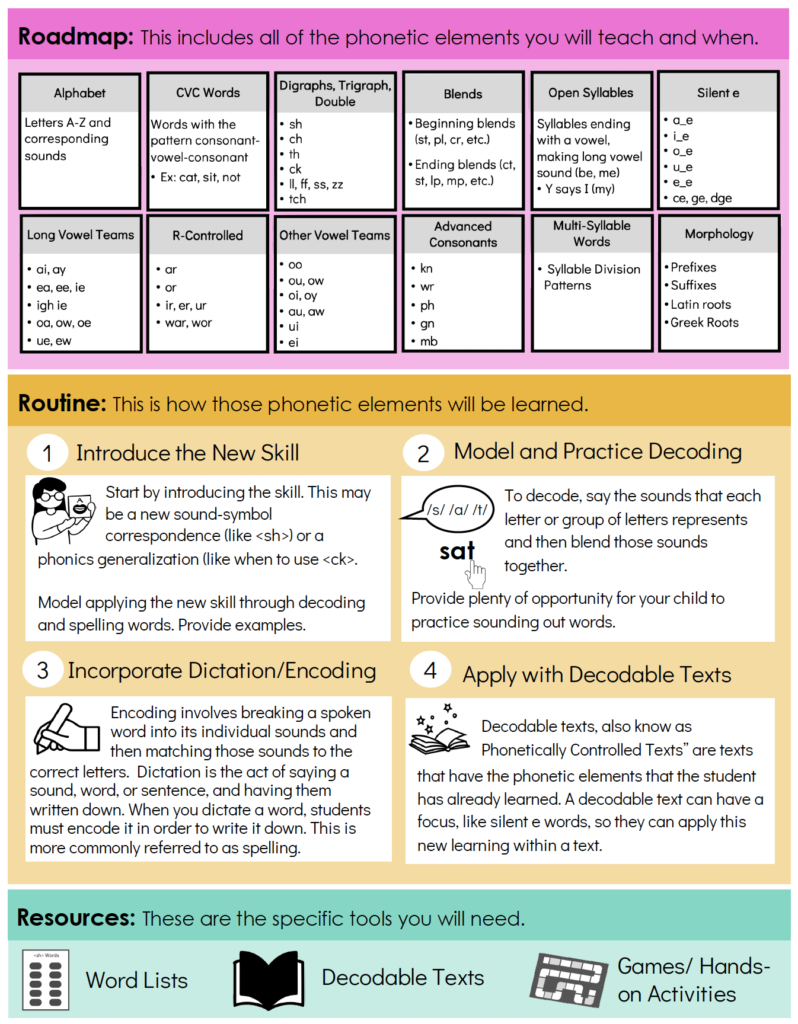
Beyond Teaching Phonics
As I mentioned earlier, there is so much more to reading than just phonics. While you are working on these essential foundational skills, it is so important to continue to read to your child so they can develop language comprehension skills, like background knowledge, and vocabulary.









